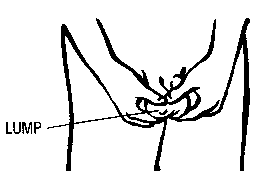How to Do a Testicular Self Examination:
For men over the age of 14, a monthly self-exam of the testicles is an effective way of becoming familiar with this area of the body and thus enabling the detection of testicular cancer at an early -- and very curable -- stage. Why do you need to do it monthly? Because the point of the self exam is not to find something wrong today. The point is to learn what everything feels like when things are normal, and to check back every month to make sure that nothing has changed. If something HAS changed, you will know it and you can do something about it.
The testicular self exam is best performed after a warm bath or shower.
(Heat relaxes the scrotum, making it easier to spot anything abnormal)
Here is how to do the self exam: 
- If possible, stand in front of a mirror. Check for any swelling on the scrotal skin.
- Examine each testicle with both hands.
Place the index and middle fingers under the testicle with the thumbs placed
on top. Roll the testicle gently between the thumbs and fingers -- you
shouldn't feel any pain when doing the exam. Don't be alarmed if one testicle
seems slightly larger than the other, that's normal.
- Find the epididymis, the soft, tubelike structure behind the testicle
that collects and carries sperm. If you are familiar with this structure,
you won't mistake it for a suspicious lump. Cancerous lumps usually are
found on the sides of the testicle but can also show up on the front.
Lumps on or attached to the epididymis are not cancerous.
- If you find a lump on your testicle or any of the other signs of testicular cancer listed below, see a doctor, preferably a urologist,
right away. The abnormality may not be cancer, but if it is testicular cancer, it will spread if it is not
stopped by treatment. Even if it is something else like an infection, you are still going to need to see a doctor. Waiting and hoping will not fix anything. Please
note that free floating lumps in the scrotum that are not attached in any
way to a testicle are not testicular cancer. When in doubt, get it
checked out - if only for peace of mind!
Other signs of testicular cancer to keep in mind are:
- Any enlargement of a testicle
- A significant loss of size in one of the testicles
- A feeling of heaviness in the scrotum
- A dull ache in the lower abdomen or in the groin
- A sudden collection of fluid in the scrotum
- Pain or discomfort in a testicle or in the scrotum
- Enlargement or tenderness of the breasts
I hesitate to mention the following list, since anything out of the ordinary down
there should prompt a visit to the doctor, but you should be aware that the
following symptoms are not normally signs of testicular cancer:
- A pimple, ingrown hair or rash on the scrotal skin
- A free floating lump in the scrotum, seemingly not attached to anything
- A lump on the epidiymis or tubes coming from the testicle that kind of feels
like a third testicle
- Pain or burning during urination
- Blood in the urine or semen
*** Remember, only a physician can make a positive diagnosis ***
For that matter, only a physician can make a negative diagnosis too. If
you think something feels strange, go see the doctor!
Finally, embarassment is a poor excuse for not having any problem examined by a doctor.
If you think there is something wrong or something has changed, please see your doctor!
For information on a number of related topics, please check out these links:


